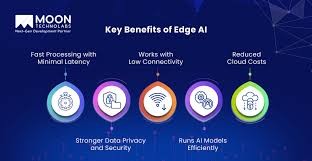
Edge AI is rapidly emerging as a transformative force in the way businesses and consumers interact with technology. At its core, Edge AI refers to the deployment of artificial intelligence algorithms directly on devices—such as smartphones, sensors, cameras, and industrial machines—rather than relying on centralized cloud servers. This shift in processing location brings a host of benefits that are reshaping industries, improving user experiences, and enabling smarter, faster decision-making. By moving intelligence closer to where data is generated, Edge AI offers a compelling alternative to traditional cloud-based models, especially in environments where speed, privacy, and reliability are paramount.
One of the most immediate advantages of Edge AI is reduced latency. When data is processed locally on the device, responses can be generated in real time without the delays associated with sending information to the cloud and waiting for a return signal. This is particularly critical in applications where timing is everything. Consider autonomous vehicles, which must make split-second decisions based on sensor input. Relying on cloud processing in such scenarios could introduce dangerous delays. With Edge AI, the vehicle can analyze its surroundings and respond instantly, enhancing safety and performance. The same principle applies to industrial automation, where machinery equipped with Edge AI can detect anomalies and adjust operations without waiting for remote instructions.
Another significant benefit is enhanced privacy and data security. In traditional cloud-based systems, sensitive data must be transmitted over networks to centralized servers, increasing the risk of interception or unauthorized access. Edge AI minimizes this exposure by keeping data on the device, where it can be processed and discarded without ever leaving the local environment. This approach is especially valuable in healthcare, where patient data must be handled with strict confidentiality. A wearable health monitor using Edge AI can analyze biometric signals and alert users to potential issues without transmitting personal information to external servers. This not only protects privacy but also aligns with regulatory requirements around data handling.
Bandwidth efficiency is also improved through Edge AI. As the number of connected devices continues to grow, so does the volume of data they generate. Transmitting all this information to the cloud can strain networks and lead to congestion. By processing data locally, Edge AI reduces the need for constant communication with remote servers, freeing up bandwidth for other critical tasks. This is particularly useful in remote or bandwidth-constrained environments, such as rural areas or offshore facilities, where connectivity may be limited or expensive. Devices equipped with Edge AI can operate autonomously, making intelligent decisions and syncing with the cloud only when necessary.
Scalability is another area where Edge AI shines. Deploying AI capabilities across a distributed network of devices allows organizations to scale their operations without overburdening centralized infrastructure. Each device becomes a node of intelligence, capable of contributing to the broader system while maintaining independence. For example, a retail chain can use Edge AI-enabled cameras to monitor foot traffic and customer behavior in each store, tailoring promotions and staffing levels based on local insights. These devices work in concert but do not rely on a single point of failure, making the system more robust and adaptable.
Edge AI also supports energy efficiency, which is increasingly important in both consumer and enterprise contexts. Processing data locally reduces the energy required for transmission and cloud computation, which can be substantial over time. Devices can be optimized to perform specific tasks with minimal power consumption, extending battery life and reducing operational costs. This is particularly relevant for battery-powered sensors in smart buildings or environmental monitoring systems, where longevity and reliability are key. By intelligently managing resources, Edge AI contributes to sustainability goals while maintaining high performance.
From a user experience perspective, Edge AI enables more responsive and personalized interactions. Devices can learn from user behavior and adapt in real time, offering tailored recommendations, alerts, or adjustments. A smart thermostat, for instance, can analyze occupancy patterns and temperature preferences to optimize climate control without relying on external data centers. This immediacy enhances convenience and satisfaction, making technology feel more intuitive and aligned with individual needs. As consumers increasingly expect seamless and intelligent experiences, Edge AI provides the foundation for delivering on those expectations.
The business implications of Edge AI are profound. Companies that embrace this technology can gain a competitive edge by offering faster, more secure, and more efficient solutions. They can innovate at the edge, creating products and services that respond to real-world conditions with agility and precision. Moreover, by reducing dependence on cloud infrastructure, businesses can lower costs and improve resilience. This is especially important in sectors like manufacturing, logistics, and energy, where downtime can be costly and operational continuity is critical.
As Edge AI continues to evolve, its integration with other technologies such as 5G, IoT, and machine learning will unlock even greater potential. The combination of high-speed connectivity and localized intelligence will enable new use cases, from smart cities and connected healthcare to predictive maintenance and immersive retail experiences. Organizations that invest in Edge AI today are positioning themselves for a future where responsiveness, autonomy, and data integrity are not just advantages—they are expectations.
In essence, Edge AI represents a shift in how intelligence is distributed across the digital landscape. By bringing processing power to the device level, it empowers faster decisions, protects privacy, conserves resources, and enhances user engagement. It’s a model that aligns with the demands of modern business and the realities of a connected world. As adoption grows, Edge AI will continue to redefine what’s possible, turning everyday devices into powerful engines of insight and action.